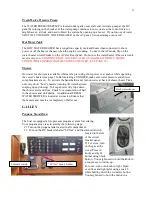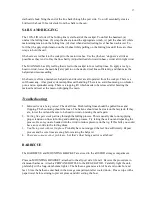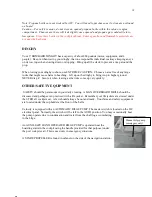
10
The HOUSE BATTERY BANK provides power for all DC systems. When disconnected from shore
power, all 12-volt devices and 110-volt devices drain the house battery.
Battery systems will lose their charge while ANCHORED or MOORED. Avoid this by using power
sparingly at anchor. Turn the refrigerator off at night. Use only one or two lights at a time. Turn off
systems not in use such as instruments, VHF, stereo, etc. If you do not need the cabin heater, turn it
off. If you stay moored for more then a day, run your engines just above idle to recharge your
batteries. WATCH YOUR VOLTAGE!
Batteries are charged by the engine ALTERNATORS while underway. The engine/house batteries
are charged by the BATTERY CHARGER when connected to shore power.
There are two 12 volt auxiliary plugs – one located on the electrical panel and the other on the helm
in the cockpit. Both of these operate off battery power alone. The electrical outlets will not work
under the DC battery system.
Note -- Do not change the position of the switches while the engines are running or the alternator
diodes will be damaged. Change positions with the engines off.
Voltage (Wet Cell Battery)
Battery State
12.65 volts 100%
12.47 volts 75%
12.25 volts 50%
11.95 volts 25%
11.70 volts 0%
SANITATION SYSTEM
Marine Toilet
It is important that every member of the crew be informed on the proper use of the MARINE
TOILET. The valves, openings, and pumps are small and may clog easily.
If the toilet clogs, it is
YOUR RESONSIBILITY!
Always pump the head for a child so you can make sure nothing foreign
is being flushed.
Caution – Never put paper towels, tampons, Kleenex,
sanitary napkins, household toilet paper, or food into
the marine toilet. Use only the special dissolving
marine toilet tissue provided by AYC.
To use the toilet, move the PUMP LEVER to the
‘left’ (wet bowl). Lift the PUMP HANDLE 3 to 5
times to wet the bowl. After using the toilet, lift the
PUMP HANDLE to wet the bowl again. Then, move
Pump Lever
Hand Pump




























